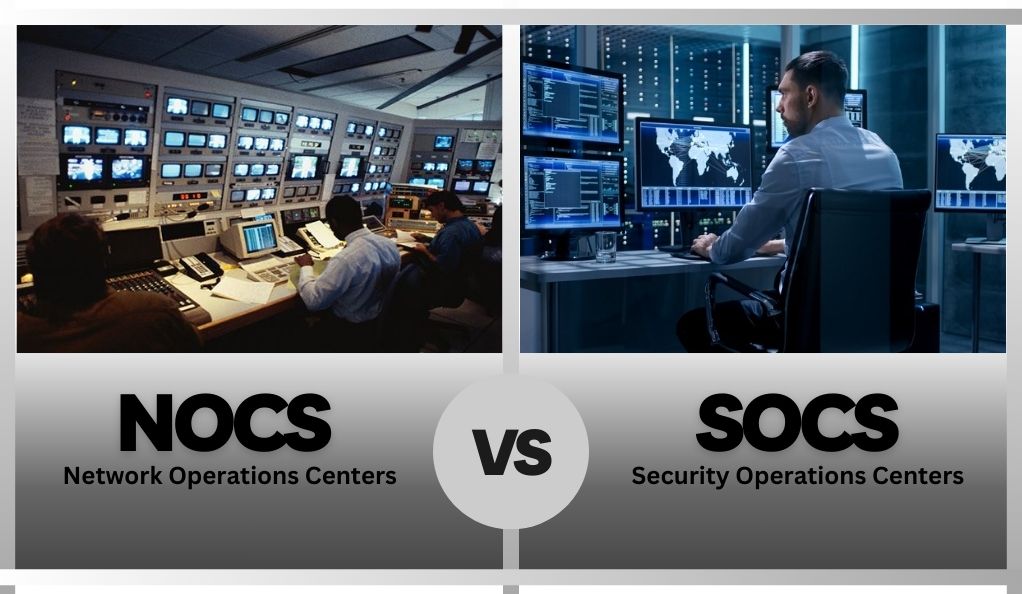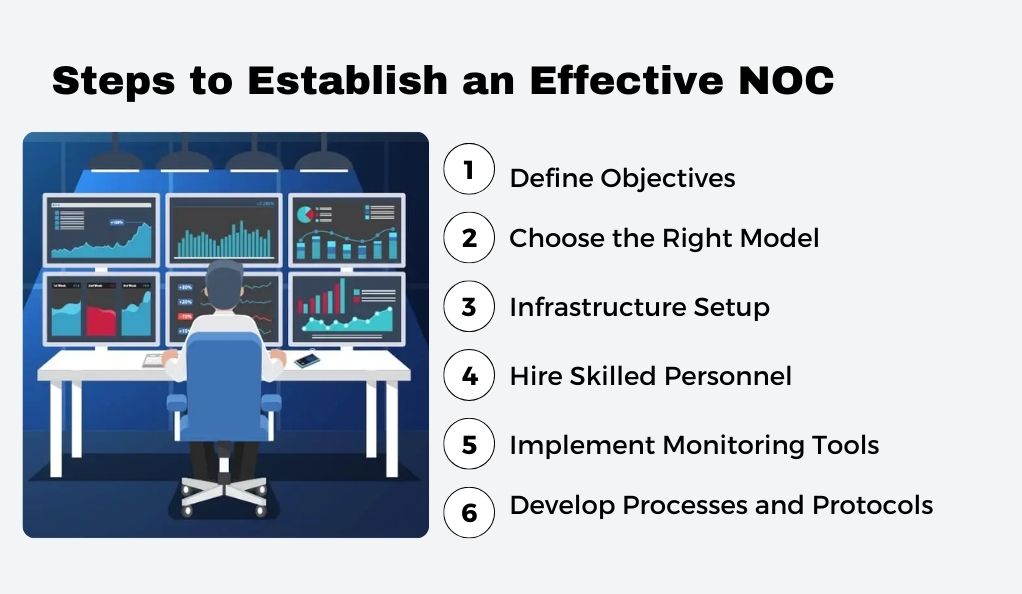The Essential Guide to NOC: Network Operations Center
Network Operations Centers (NOCs) are essential hubs in a company’s IT infrastructure, where experts monitor and manage networks to ensure seamless operation. Their role has evolved to include proactive issue prevention and emergency planning, crucial in our interconnected world.
The Evolving Role of NOCs in Modern IT Infrastructure
The role of NOCs has grown over time. In today’s world, where everything is connected, NOCs have become more crucial than ever. They’re not just about fixing issues anymore; they’re about preventing them before they happen. NOCs use advanced tools to monitor networks and catch problems early. They also play a big part in planning for emergencies and keeping businesses running no matter what. As networks get more complex, with cloud services and remote work, the NOC’s job becomes even more important. They keep everything connected and running smoothly, which is vital in a world where we rely so much on technology.
Definition and Overview of NOCs
Network Operations Centers, commonly known as NOCs (pronounced “knock”), are the beating heart of a company’s IT environment. Picture a room filled with screens and equipment where a team of experts keeps a watchful eye on networks. These centers are where IT staff manage and monitor the network’s health, making sure everything runs smoothly. Their main job is to look out for any network problems and fix them fast. This includes keeping an eye on servers, routers, and ensuring that all parts of the network are in top shape. NOCs are like the control tower at an airport, making sure that data, much like airplanes, comes and goes without any issues.
The Fundamentals of NOCs
Network Operations Centers, or NOCs, are essential parts of any organization that relies on networks for daily operations. They act like the command center for managing, monitoring, and maintaining network health. NOCs are vital in ensuring that networks are efficient, secure, and continuously running.
Core Functions and Responsibilities
- Monitoring Network Health: NOCs constantly check the health of the network. They use tools to watch over network traffic, server health, and other critical metrics.
- Managing Incidents: When a problem is detected, NOC staff take immediate action. They figure out what’s wrong and work quickly to fix it.
- Preventing Issues: NOCs aren’t just about reacting to problems. They also work to prevent them by analyzing network trends and addressing potential issues before they become big problems.
Network Monitoring and Management
- Real-Time Observation: NOCs use real-time data to keep an eye on the network. This means watching network performance as it happens, which helps in spotting issues quickly.
- Managing Network Equipment: This includes routers, switches, and servers. NOCs ensure these are all working properly and are up to date with the latest software.
Incident Response and Problem Solving
- Quick Response to Network Issues: When something goes wrong, NOC teams jump into action. Their goal is to fix issues as fast as possible to minimize any downtime.
- Problem Analysis and Resolution: They look into why an issue happened and find the best way to fix it. This might involve tweaking network settings or replacing faulty equipment.
Importance in Business Continuity and Disaster Recovery
- Keeping Business Running: NOCs are crucial in making sure a business keeps running smoothly, even when there are network problems.
- Planning for Emergencies: They also play a big role in preparing for and handling emergencies like power outages or cyber attacks, ensuring the network is always up and running.
NOCs vs. SOCs: Understanding the Differences

In the world of IT management, both Network Operations Centers (NOCs) and Security Operations Centers (SOCs) play crucial roles. They might seem similar at first glance, but they focus on different areas of network management and security.
Distinct Roles in Network Management and Security
- NOCs: Focus on Network Performance and Uptime
- NOCs concentrate on keeping the network running smoothly. This includes monitoring network traffic, managing network devices, and fixing connectivity issues.
- The main goal is to ensure network reliability and efficiency.
- SOCs: Concentrate on Security Monitoring and Response
- SOCs deal with the security aspect of IT. They are all about detecting, analyzing, and responding to cybersecurity incidents.
- Their objective is to protect the organization from security threats like hacking, malware, and data breaches.
Collaboration Between NOCs and Security Operations Centers
Working Together for Comprehensive IT Management
- Although NOCs and SOCs have different roles, they often work closely together. NOCs handle the overall health of the network, while SOCs focus on security threats.
- By collaborating, they ensure the network is not only running efficiently but is also secure from threats.
Shared Goals for Network Stability and Security
- Both teams aim to minimize downtime and protect the organization’s IT infrastructure.
- Effective communication and coordination between NOCs and SOCs are essential for a well-rounded IT strategy.
NOC Infrastructure and Technologies
The Network Operations Center (NOC) is not just about the team of experts monitoring the network; it’s also about the technology and tools they use. The infrastructure and technologies in a NOC are designed to provide comprehensive network monitoring and management.
Key Components of a NOC
- Advanced Monitoring Software: NOCs use sophisticated software that helps them keep track of network health in real-time. This software alerts the team to any potential issues before they become bigger problems.
- Hardware and Network Equipment: This includes servers, routers, switches, and other devices that help manage data flow and network connectivity.
- Communication Tools: Efficient communication within the NOC team and with other departments is crucial. NOCs use various communication tools to ensure quick and effective responses.
Advanced Tools and Technologies Used in NOCs
- Automated Alert Systems: These systems automatically notify NOC staff about potential network issues, allowing for quick action.
- Data Analytics and Reporting Tools: These tools help in analyzing network performance over time, identifying trends, and making informed decisions to improve network efficiency.
- Remote Monitoring Capabilities: NOCs can monitor and manage networks from different locations, which is particularly useful for businesses with multiple sites or remote work arrangements.
The Importance of Real-Time Monitoring and Automated Systems
- Proactive Network Management: Real-time monitoring allows NOC teams to catch and resolve issues as they happen, rather than reacting after the fact.
- Efficiency and Accuracy: Automated systems reduce the chance of human error and free up staff to focus on more complex tasks that require human intervention.
Setting Up a Network Operations Center
Establishing a Network Operations Center (NOC) is a significant step for organizations looking to enhance their network management and monitoring capabilities. Setting up a NOC involves careful planning, resource allocation, and strategic decisions.
In-House vs. Outsourced NOCs
- In-House NOCs:
- Building an in-house NOC means setting up the center within your organization. This includes investing in infrastructure, hiring specialized staff, and managing the NOC directly.
- Advantages include direct control over operations and the ability to tailor the NOC to specific organizational needs.
- Outsourced NOCs:
- Outsourcing involves hiring an external company to handle your NOC functions. This can be more cost-effective and less resource-intensive than building an in-house NOC.
- Benefits include access to specialized expertise and the ability to scale services according to need.
Steps to Establish an Effective NOC

- Define Objectives: Clearly outline what you want your NOC to achieve, such as improved network uptime, efficient incident response, or enhanced security.
- Choose the Right Model: Decide between setting up an in-house NOC or outsourcing to a service provider based on your needs and resources.
- Infrastructure Setup: For an in-house NOC, invest in the necessary technology, tools, and physical space. For outsourced NOCs, select a provider with the right capabilities.
- Hire Skilled Personnel: Ensure you have a team with the necessary skills and experience, whether for an in-house setup or as part of an outsourced service.
- Implement Monitoring Tools: Choose and set up network monitoring and management tools that align with your objectives.
- Develop Processes and Protocols: Establish clear procedures for network monitoring, incident response, and ongoing maintenance.
Challenges and Considerations in NOC Implementation
- Budget Constraints: Setting up and running a NOC can be expensive. Careful budgeting and cost analysis are essential.
- Finding the Right Talent: Skilled NOC personnel are crucial. The challenge lies in recruiting and retaining the right talent.
- Ensuring Scalability: Your NOC should be able to grow with your organization. Consider future needs and scalability when setting up your NOC.
Best Practices for NOC Management
Effective management is key to the success of a Network Operations Center (NOC). It involves not just overseeing network operations but also ensuring that the NOC adapts to changing technologies and network demands. Following best practices in NOC management can significantly improve network performance and reliability.
Essential Skills and Training for NOC Staff
- Continuous Learning: NOC staff should be encouraged to keep up with the latest network technologies and management strategies. This could include regular training sessions and certifications.
- Problem-Solving Skills: Staff should be adept at quickly identifying and resolving network issues, requiring strong analytical and troubleshooting skills.
- Communication Abilities: Effective communication within the NOC team and with other departments is crucial for swift and efficient network management.
Developing Effective Communication Protocols

To maintain efficient network operations, organizations should implement clear reporting structures, outlining procedures for reporting network issues, performance metrics, and incident resolutions. Additionally, the use of collaboration tools, such as internal chat applications and collaboration platforms, facilitates seamless information sharing among team members. Regular meetings dedicated to discussing network performance, ongoing challenges, and upcoming issues are essential, fostering alignment and teamwork within the organization to achieve common network management objectives.
Ensuring Continuous Improvement and Adaptation
- Feedback Loops: Implement a system for collecting and analyzing feedback from both NOC staff and network users. This feedback can guide improvements in network management and operations.
- Performance Reviews: Regularly review network performance data to identify trends, potential problems, and areas for improvement.
- Adapting to Changes: Be prepared to adapt strategies and tools to meet evolving network requirements and technologies.
The Future of NOCs in IT Management
The role of Network Operations Centers (NOCs) in IT management is constantly evolving. As technology advances and the demands on networks increase, NOCs are expected to adapt and innovate. Looking ahead, the future of NOCs is shaping up to be an exciting and pivotal aspect of IT management.
Emerging Trends and Technologies
- Automation and AI: NOCs are likely to increasingly use automation and artificial intelligence (AI) to enhance network monitoring and management. This means more efficient problem-solving and less downtime.
- Cloud Integration: As more organizations move to cloud-based solutions, NOCs will need to adapt to manage these environments effectively.
- Advanced Security Measures: With cybersecurity threats on the rise, NOCs will play a crucial role in implementing and overseeing more advanced security protocols.
The Growing Importance of NOCs in Cybersecurity
NOCs are shifting towards proactive threat detection and response, employing advanced tools to identify and mitigate potential threats before they disrupt network performance. Moreover, enhanced collaboration with Security Operations Centers (SOCs) ensures a holistic approach to IT security and management.
Predictions for NOC Evolution
- Enhanced Remote Capabilities: The ability to manage networks remotely will become even more refined, allowing NOCs to efficiently handle networks spread across various geographical locations.
- Customizable and Scalable Services: NOCs will offer more customizable and scalable services to cater to the specific needs of different organizations.
- Focus on User Experience: There will be a greater focus on enhancing the end-user experience, ensuring that network management aligns with user needs and expectations.
Conclusion
Network Operations Centers (NOCs) play a crucial role in today’s IT landscape. They are the backbone of network management, ensuring that everything runs smoothly and efficiently. From monitoring network performance to responding to incidents and collaborating with Security Operations Centers (SOCs), NOCs are essential in maintaining the health and security of our digital networks.
As technology continues to evolve, so too will the functions and importance of NOCs. With advancements in AI, cloud computing, and cybersecurity, NOCs will adapt and grow to meet new challenges. They will become more efficient, more proactive, and more integral to the success of organizations.
The future of NOC is bright, filled with potential for further innovation and advancement. As the lifeline of network operations, NOCs will continue to be a key player in the world of IT management, steering the course of network efficiency and security for years to come.


Leave a Reply